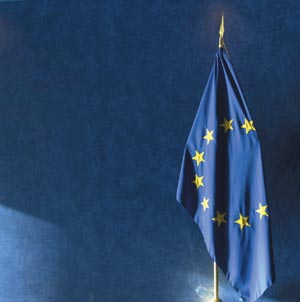As membership of the European Union increases from 15 to 25 states this month, research and development has a higher profile than ever before among the member states. The powers that be within the EU have slowly come to realize that the only way that Europe can compete with the US and Japan is to increase its investment in research. Moreover, it seems as if the shortcomings in the EU’s approach to R&D are finally being recognized, although it remains to be seen if this will lead to meaningful change.
The good news for researchers is that the EU is determined to increase spending on R&D from the 2% of gross domestic product (GDP) at present to 3% by 2010 to match current levels in the US (2.8%) and Japan (3%). The bad news is that R&D spending in the EU remained essentially constant between 2001 and 2002, and actually fell in France and the UK. The expansion of the EU will also make the 3% target more difficult to achieve because the GDPs of the accession states are likely to rise rapidly after they join, making it difficult for R&D expenditure to keep up. In terms of basic science, it is generally agreed that the EU matches the US in terms of quantity but not quality or impact.
The 10 new member states are a diverse bunch when it comes to science and research. Some, such as Poland and Hungary, have long track records, especially in physics, but others, to be blunt, do not. Overall, however, the 10 only spend €3bn per year on R&D, compared with €175bn for the 15 existing member states. However, countries such as Greece, Portugal and Spain should note that after two decades in the EU they spend less on R&D as a fraction of GDP than Slovenia and the Czech Republic.
It is good that R&D features so high on the EU agenda, but how can intentions be turned into actions? Much of the responsibility lies with industry, because the bulk of the gap between the EU and its major rivals is due to the historically low levels of investment in R&D by European companies (and high levels of expenditure on defence R&D in the US). Moreover, firms in Europe employ less than half the number of researchers that their US competitors do.
The European Commission also needs to change its approach to R&D. It is disappointing that the current Sixth Framework Programme, which will spend €17.5bn on R&D between now and 2006, is attracting many of the same criticisms as its predecessors – everything is too complicated, success rates are too low and too much of the money goes to industry. There are suggestions that the budget of the next Framework might be double that of the current programme, but the money will be wasted unless there are major changes in approach.
And what of the much discussed European Research Council (ERC) for basic research? The EU is currently considering a proposal from an “expert group” chaired by Federico Mayor to establish a European Fund for Research Excellence that would be overseen by such a council (www.ercexpertgroup.org). Many of the ideas put forward by the group – and by other interested parties like the Royal Society in the UK – have merit. To be specific, the ERC needs its own budget (ball-park figures are €1-2bn per year) and real autonomy from the Framework programme. Moreover, existing budgets for R&D should not be reduced to pay for the ERC, and, crucially, only those projects that are truly excellent must be funded.
The EU needs to take these messages on board and accept the fact that ERC research grants are more likely to go to institutes and nations that are already have strong track records. There are enough other EU schemes to support less prosperous regions – including various regulations in the Framework programme – for this not to be a problem.




